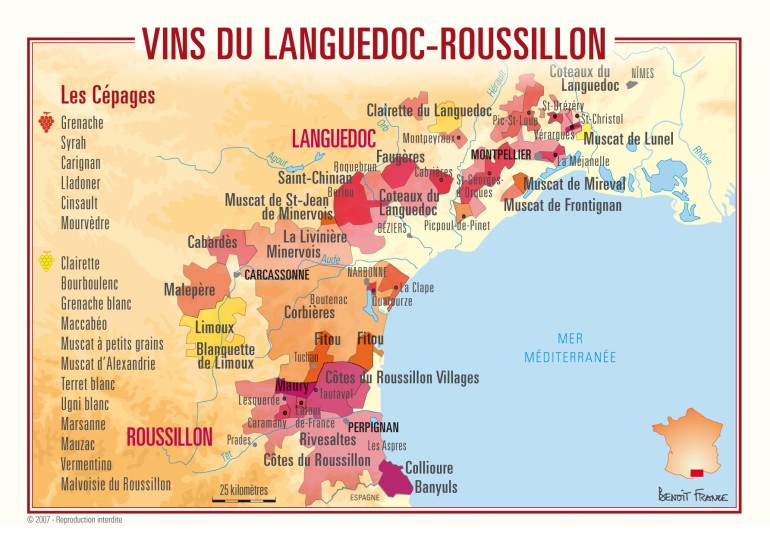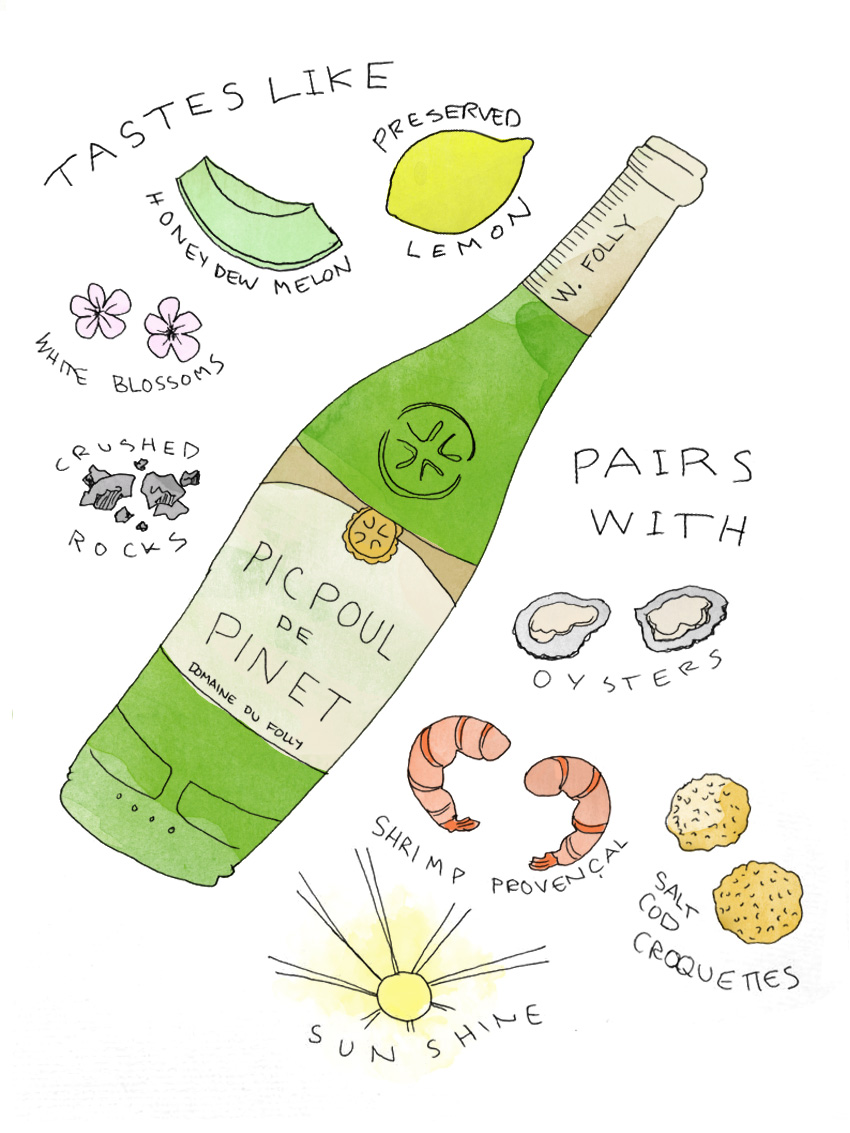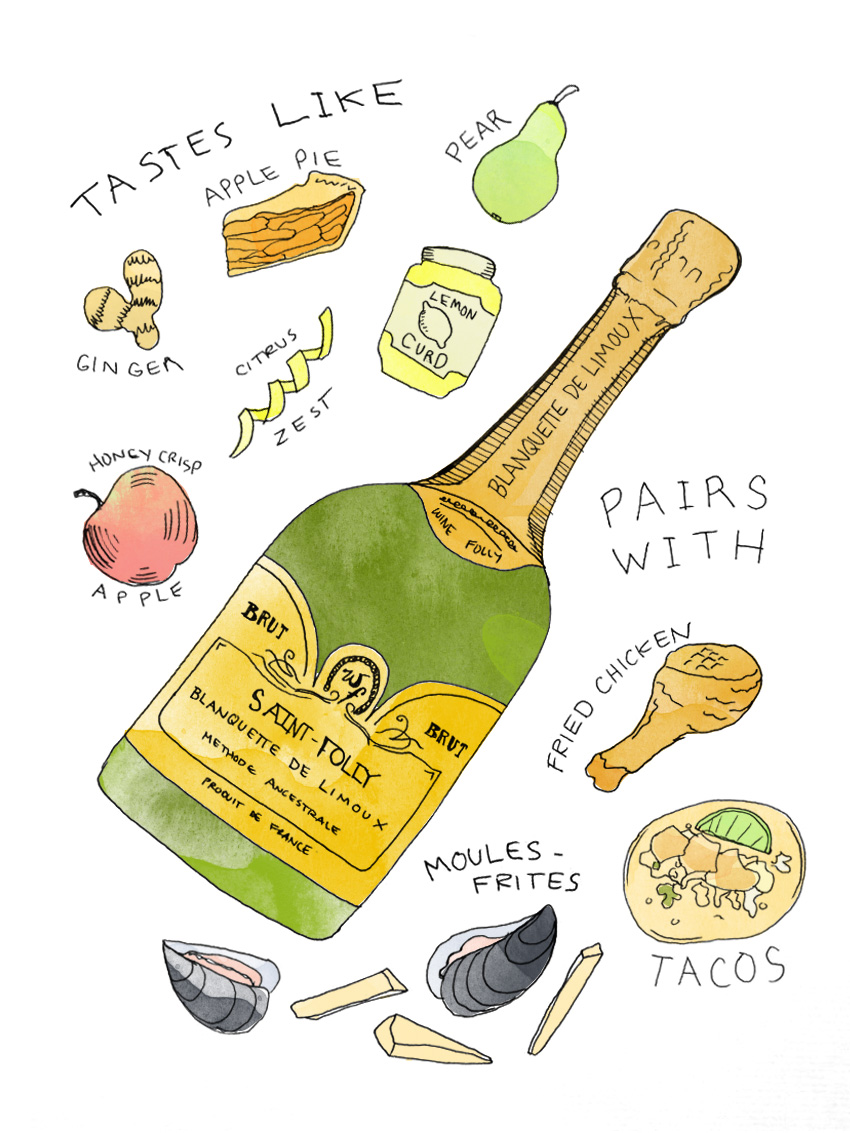Picpoul means “lip stinger” and is just one of the intriguing white wines from the Languedoc-Roussillon region of France. Find out more about this Mediterranean paradise of sunshine friendly wines.
Fun, bright, easy, light… That sounds like the description for the ideal summer day. This also happens to be the style of a group of lesser-known wines from the Languedoc-Roussillon region, an area that spans from Nîmes to Spain, just west of the French Riviera. The wines of Languedoc-Roussillon are a patchwork quilt of colors and styles, dry/sweet/still/sparkling/fortified, all made under the Mediterranean sun.

The Languedoc-Roussillon wine region. Postcard by Benoit-France.
Languedoc-Roussillon, in fact, is the largest wine producing region of France with roughly 584,400 acres. About 25% of France’s total wine production comes from the Languedoc (“long-dock”) and Roussillon. The region is no stranger to winemaking, as grapes were first planted in 125 BC near the Roman colony Narbo, or modern day Narbonne, in the production zone of Corbières.
Picpoul de Pinet
- Tasting Notes: preserved lemon, honeydew melon, white blossoms, white peach, crushed rocks
- Food Pairing: oysters, prawns Provençal, salt cod croquettes, carbonara pasta, all-around great with seafood
Picpoul de Pinet displays flavors of lemon and saline, white blossoms and wet stones. Literally translated, Picpoul means “stings the lip,” referring to the grape’s naturally sky-high acidity. These wines are light to medium bodied, bone dry, have mouth watering acidity, and typically a moderate alcohol level. These wines are France’s answer to Portugal’s Vinho Verde can be found in the AOP region Picpoul de Pinet. They’re an excellent, affordable alternative to Sauvignon Blanc or Pinot Grigio.
Picpoul isn’t planted in many places outside of Southern France. That said, occasionally you’ll find a home-grown example from Washington or California, which can provide you with a fun comparison exercise.
Blanquette de Limoux
- Blanquette de Limoux Tasting Notes: lemon curd, sweet apple, citrus zest, baked apple pie, pear, ginger
- Food Pairing: fried chicken, moules-frites, fish or chicken tacos, and other highly flavored fried foods
Limoux is a region that produces wines from four separate AOC regions dedicated to four prominent styles of wine, three of which are sparkling: Blanquette de Limoux, Blanquette Methode Ancestrale, Crémant de Limoux, and one still wine appellation – Limoux. One fun, esoteric varietal to know, indigenous to the Languedoc is Mauzac; Mauzac, along with Chardonnay, Chenin Blanc, and sometimes a pinch of Pinot Noir constitute the blend in Limoux sparkling wines.
Ma-wha? I feel you.
Mauzac Blanc (mow-zack) is a very old white grape that produces wines with peachy flavors and aromas reminiscent of tart green apple skins, with grassy undertones. These flavors are brilliant building blocks for sparkling wines, and as such, Mauzac is the star of the show when it comes to the Blanquette de Limoux and Blanquette Methode Ancestrale. Even though Mauzac is not well-known outside the region, it’s quite possible that this was the grape that went into first sparkling wine!
The first sparkling wine, Blanquette Methode Ancestrale, has been traced back to 1531 (that’s right, even before Champagne in 1668) where it was produced by the monks in the Abbey of St-Hilaire. The abbey was visited by none-other-than Dom Perignon on his pilgrimage to Santiago de Compostela. It has thus been supposed that Dom Perignon brought back the winemaking secrets of Limoux and created the first Champagne.
Methode Ancestrale sparkling wine originated when sluggish yeasts grew dormant from the autumn cold, but wines were bottled anyway, residual sugar and all. When the weather started to warm the following spring, the yeasts reawakened and continued on their quest to consume all the sugar. When yeasts feast, carbon dioxide is produced, and in closed quarters that CO2 gets absorbed into the wine, creating fizz. The result? A frizzante, or semi-sparkling style of wine with a touch of sweetness, combined with apple-y flavors that are almost reminiscent of apple cider. Seriously cool!
Unfortunately, Blanquette Methode Ancestrale is quite hard to find outside of Southern France (you might have to plan a trip!). So, if you need a Limoux fix, Crémant de Limoux is more commonly available and it is amazing. Made in a traditional method style (like Champagne), it uses Chardonnay and Chenin Blanc grapes, with a small percentage of Mauzac. Crémant doesn’t age as strictly, and the land comes with a kinder price tag. That, coupled with the over 300 co-ops in the region, means that Crémant is the new (affordable) Tuesday night Champagne.
I think I just made myself thirsty.


